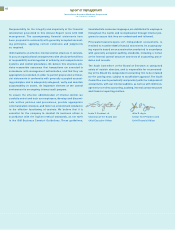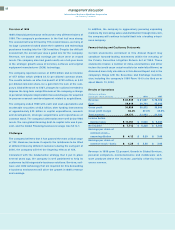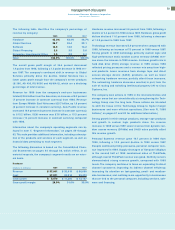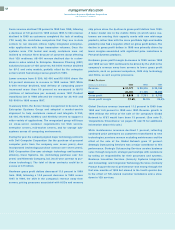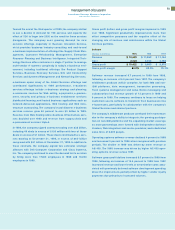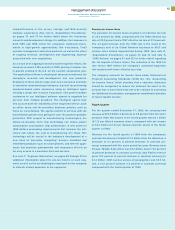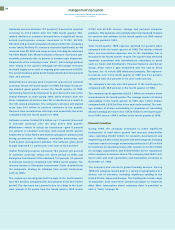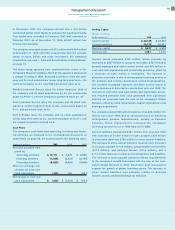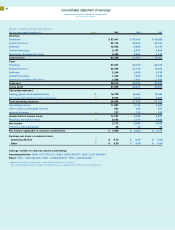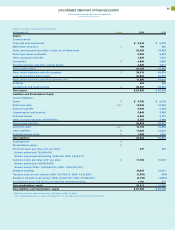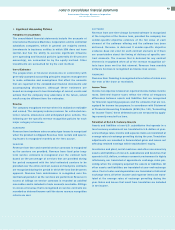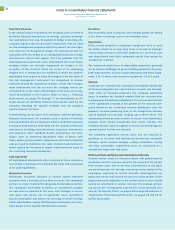IBM 1999 Annual Report Download - page 62
Download and view the complete annual report
Please find page 62 of the 1999 IBM annual report below. You can navigate through the pages in the report by either clicking on the pages listed below, or by using the keyword search tool below to find specific information within the annual report.
management discussion
International Business Machines Corporation
and Subsidiary Companies
Investments
The company’s investments for plant, rental machines and other
property were $5,959 million for 1999, a decrease of $561 million
from 1998. The company continues to invest significantly in its
rapidly growing services business, primarily in the management
of customers’ information technology, and in manufacturing
capacity for HDDs and microelectronics.
In addition to software development expenses included in
research, development and engineering, the company capital-
ized $464 million of software costs during 1999, an increase of
$214 million from the 1998 period. The increase resulted pri-
marily from the adoption by the company as of January 1, 1999,
of the American Institute of Certified Public Accountants
Statement of Position (SOP) 98-1, “Accounting for the Costs of
Computer Software Developed or Obtained for Internal Use.”
The SOP requires the capitalization of internal use computer
software if certain criteria are met. The company amortizes the
capitalized costs over two years. Amortization of capitalized
software costs (both internal use and licensed programs) was
$426 million in 1999, a decline of $91 million from 1998.
Investments and sundry assets were $26,087 million at the end
of 1999, an increase of $2,577 million from 1998, primarily the
result of increases in prepaid pension assets, customer loan
receivables-not yet due, and alliance investments, which include
investments in high-growth-potential technology companies.
See note G, “Investments and Sundry Assets,” on page 73 for
additional information.
Debt and Equity
(Dollars in millions) 1999 1998
Non-global financing debt $÷«1,555 $«««1,659
Global financing debt 26,799 27,754
Total debt $«28,354 $«29,413
Stockholders’ equity $«20,511 $«19,433
Debt/ capitalization 58.0% 60.2%
EBITDA/ Interest expense 9x 8x
Non-global financing:
Debt/ capitalization 9.0% 9.9%
EBITDA/ Interest expense 19x 15x
Global financing debt/ equity 5.5:1 6.5:1
Because a financing business has a different capital structure
than a technology business, the company’s debt and key financial
ratios are calculated on both a global financing and non-global
financing basis.
Total debt decreased $1,059 million from year-end 1998 as debt
supporting the growth of global financing assets decreased $955
million and non-global financing debt decreased $104 million.
Stockholders’ equity increased $1,078 million to $20,511 million
at December 31, 1999, primarily due to the increase in retained
earnings and accumulated gains and losses not affecting
retained earnings, partially offset by the company’s ongoing
stock repurchase program. (See note N, “Stockholders’ Equity
Activity,” on pages 78 and 79.)
The ratio of non-global financing earnings before interest and
taxes plus depreciation and amortization (EBITDA) to non-
global financing interest expense, adjusted for future gross
minimum rental commitments, was 19x and 15x in 1999 and
1998, respectively. EBITDA is a useful indicator of the company’s
ability to service its debt.
Currency Rate Fluctuations
Changes in the relative values of non-U.S. currencies to the
U.S. dollar affect the company’s results. At December 31, 1999,
currency changes resulted in assets and liabilities denominated
in local currencies being translated into fewer dollars than at
year-end 1998. The currency rate changes had minimal effect
on 1999 revenue growth, but had an unfavorable effect on 1998
and 1997 revenue growth of approximately 2 percent and 5 per-
cent, respectively.
In high-inflation environments, translation adjustments are
reflected in period income, as required by SFAS No. 52, “Foreign
Currency Translation.” Generally, the company limits currency
risk in these countries by linking prices and contracts to U.S.
dollars, financing operations locally and entering into foreign
currency hedge contracts.
The company uses a variety of financial hedging instruments to
limit specific currency risks related to global financing transactions
and the repatriation of dividends and royalties. Further discussion
of currency and hedging appears in note L, “Financial Instruments,”
on pages 75 through 77.
60


